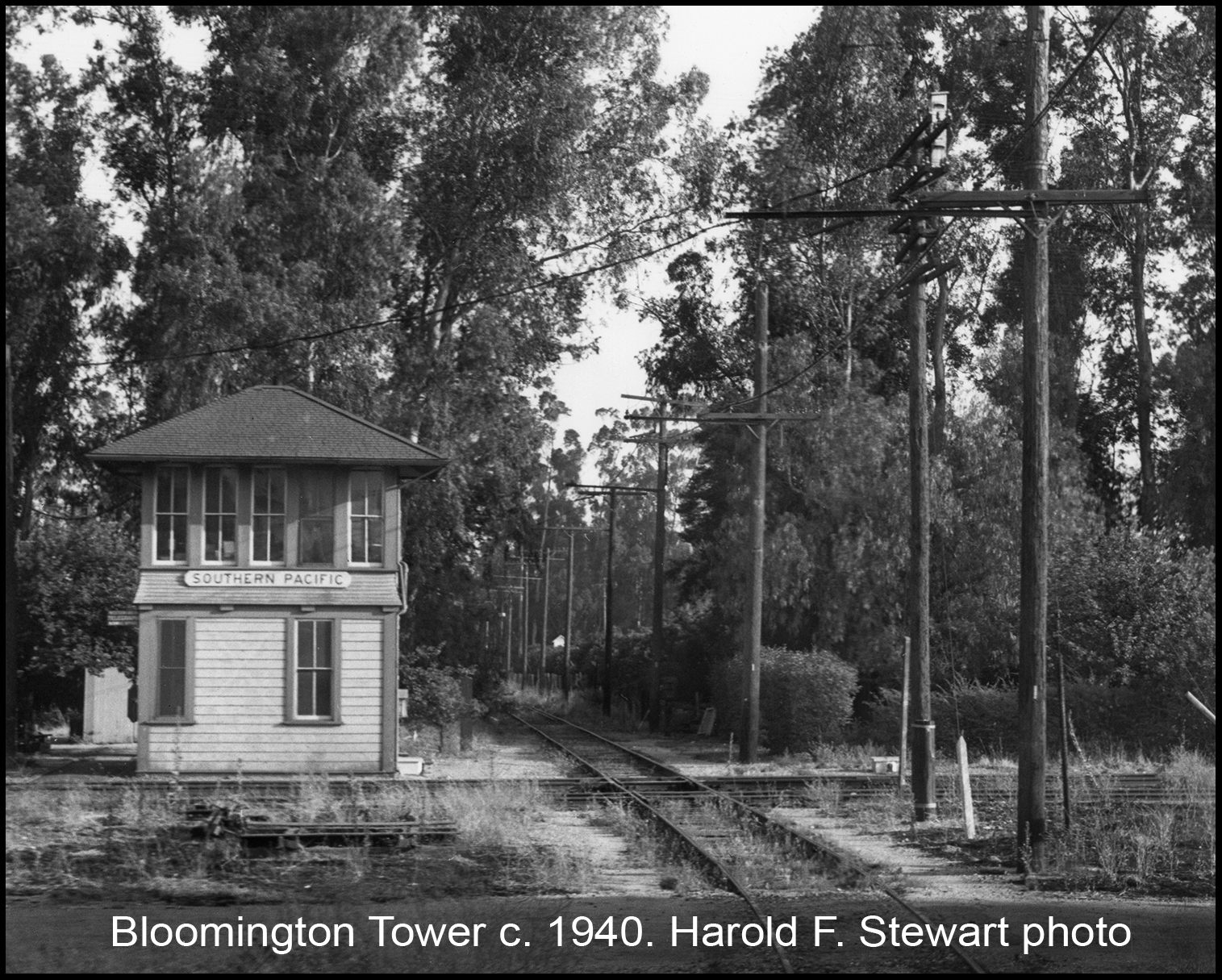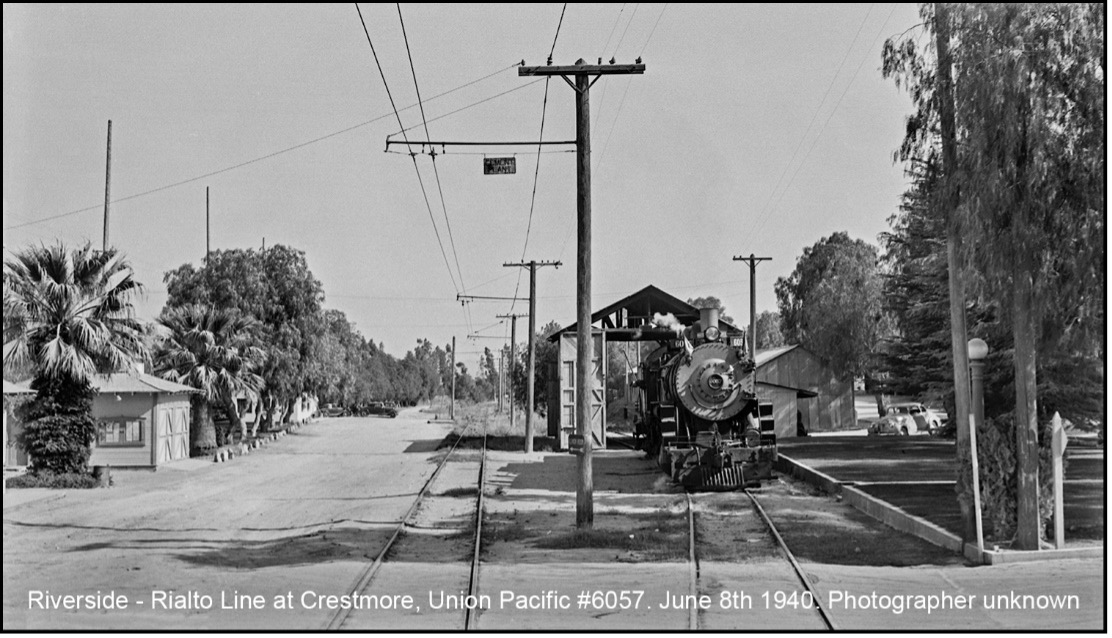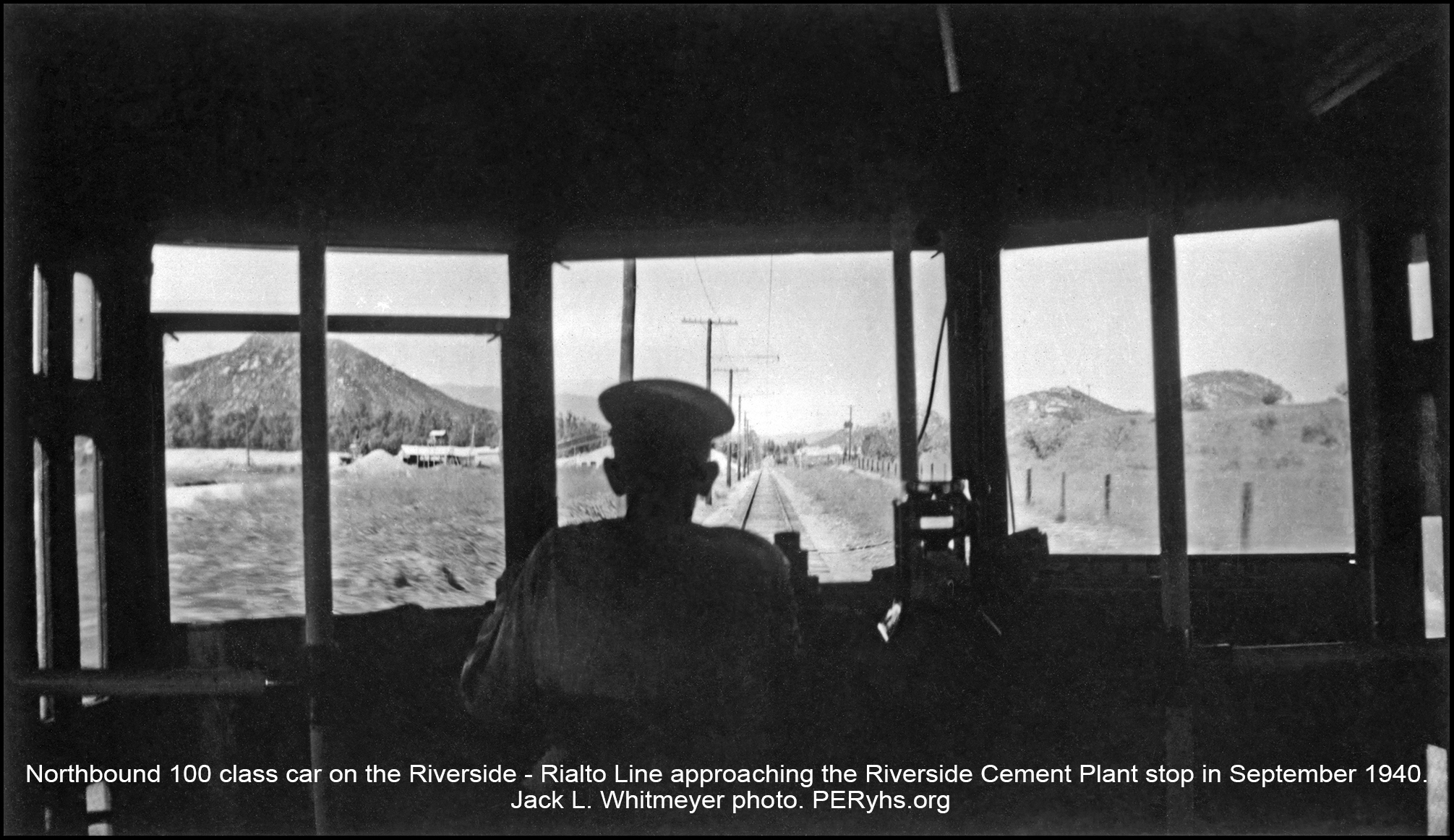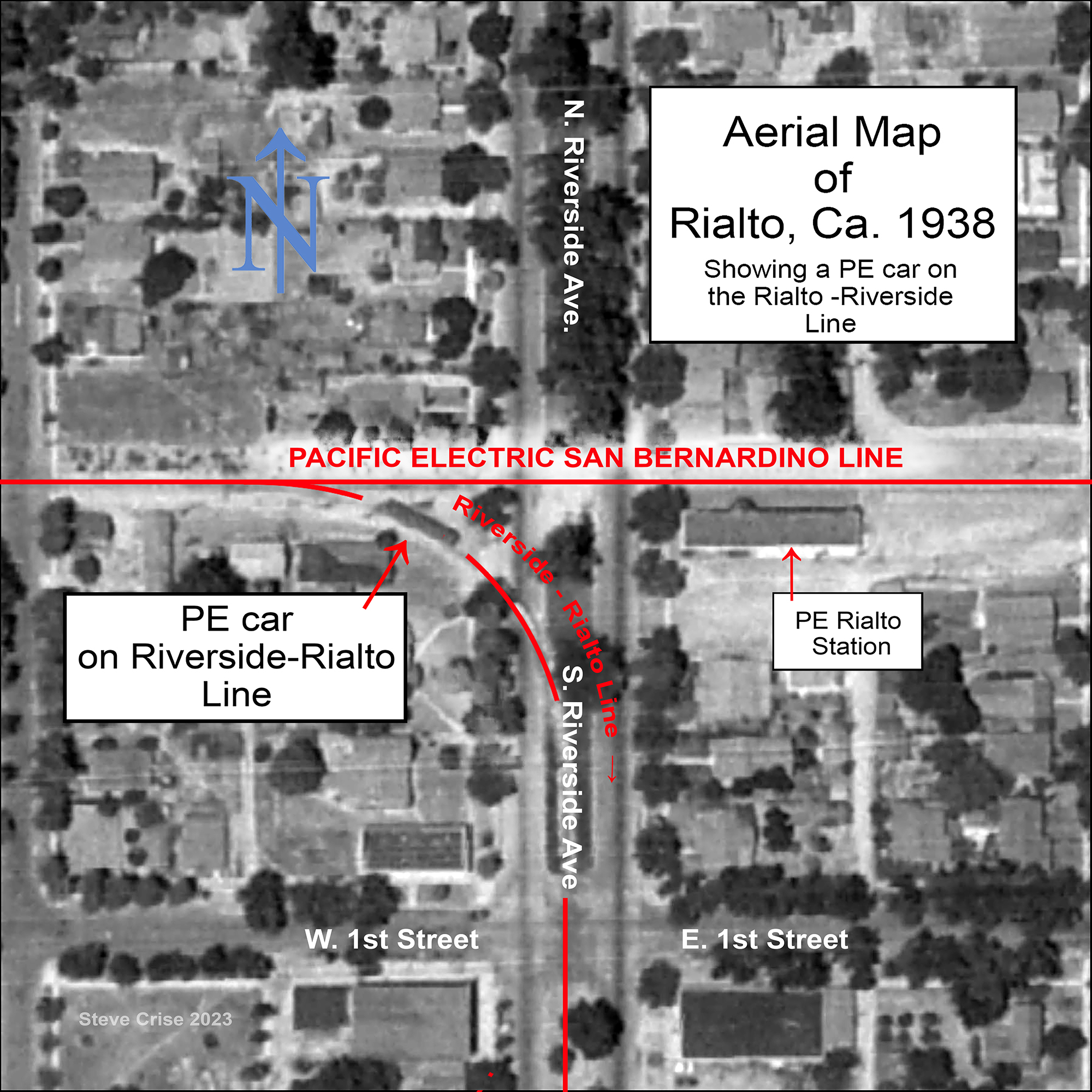Riverside – Rialto Line
Above: A meet at Rialto Junction on June 8, 1940. The car on the right will soon depart for Riverside while the car on the left will continue its journey to San Bernardino.
An Excerpt from The Lines of the Pacific Electric; Eastern District, by Ira Swett, 1954
Maps by R.E. Younghans
Research by Steve Crise
Images provided by PERYhs.org
The Crestmore Line (Riverside – Rialto) was unique in that it was not owned by the Pacific Electric; Union Pacific owned it in modern times but nevertheless it was a vital link in PE’s rail empire. Its 9.33 miles cut off the corner for trains to and from Los Angeles, saving Riversiders about 5.5 miles of extra travel had they been forced to journey on PE’s own rails via Colton and San Bernardino. Local service was provided on the Crestmore Line for many years, chiefly to serve the large Riverside Portland Cement Company’s plant near Crestmore. Interurbans provided nearly all the through service, doing local work en route. Under the agreement made by P.E. and U.P., all passenger service on this line was provided by P.E., while freight trains were operated by both railroads; P.E. using electric locomotives, U.P. using steam.

Route
From the Rialto P.E. Station, south on Riverside Avenue, and private right of way; crossed AT&SF’s (Santa Fe) main line at MP (mile post) 0.50, and S.P.’s (Southern Pacific) main line at MP 3.40; then came Bloomington (MP 3.50), Cement Plant (MP 5.90) Alvarado (MP 7.99), Alamo (MP 8.45), Hancock (MP 8.89), and finally the Riverside P.E. Station (MP 9.58). The entire route was single track.

History
In 1907 the Riverside Portland Cement Company built a large operation near Crestmore, and to provide transportation for employees, built a standard gauge railroad to Riverside. On February 28th, 1908, this line (known as “The Crescent City Railway Company”) entered into an agreement with the Riverside and Arlington Railway Company by which the line was electrified. The R&A provided express and passenger service over it. The first electric car ran over the line on May 1st, 1908. On May 20th, 1911, the line was opened to Bloomington, and the final extension to Rialto opened on March 24th, 1914. The P.E. began through service to L.A. over this line on March 15th, 1915. All service was abandoned on June 9th, 1940 (franchise car to November 18th).
Operation
Service opened between Rialto and Riverside with a 90-minute headway. By 1921 we find 12 round trips daily plus three trippers each way between Riverside and Cement Plant. In 1924, 1926, 1928, 1929 and 1930 the dozen round trips daily prevailed as shown in the P.E.’s employees’ timetables, but the Cement Plant trippers dropped to two in March 1930 and to one in November 1930. The October 9th, 1932 timetable shows but nine through trips and no trippers; this was increased to ten through trips on April 15th, 1934, but was cut back to nine the following April 1st. This continued until April 11th, 1938, when service suffered a cut to but five round trips; this was cut to four on May 8th, 1939, and to one on June 9th, 1940.
The following data covers the only local cars: the best year for the line was 1914, when 360,694 passengers were carried, requiring 101,863 car miles with revenue of $16,098. In 1920, these figures became 123,728, — 37,927 — $14,424 respectively. In 1926 they dropped to 39,560 — 15,330 — $3,666 respectively. The average number of local passengers carried daily in 1926 was 108. For 1926, costs of operation was estimated to be $3,066 and taxes were $175, leaving a net income of but $425. In 1926, local cars made one round trip daily between Riverside and Rialto and three round trips between Riverside and Cement Plant. The former was a franchise trip, and the latter cared for workers meeting shift changes. One 400 class car was required.

Miscellany
Trolley voltage on this line was 600 (volts DC), supplied by substations No. 27 at Riverside; substation No. 47 at Rialto put out 1200 volts only for the main (San Bernardino Line). As a result, weak power was a serious problem. From Rialto to Riverside was downgrade and power shortage was not a factor; in the reverse direction, the drop in voltage due to the operation of heavy 1200 Class cars affected the speed of the cars and illumination inside them to a marked degree. This condition was made even worse when P.E. freight trains were on the line. The solution was to change to 1200 volts, but this would have required rebuilding of overhead (wire), installing a 1200 – volt motor generator set at Riverside, and eliminating local cars from the line. Due to the crowded conditions of the Riverside substation, a new building would have been required. This would have totaled nearly $100,000, so it was never done.
The most glamorous trains on this line were the “Orange Empire,” “Citrus Belt Limited” and “Angel City Limited.” As of 1921, all were run daily, with the first two operating outbound from Los Angeles and “Angel City Limited” operating inbound. “Orange Empire” departed Rialto at 10:38am, arriving Riverside 11:00am; “Citrus Belt Limited” left Rialto at 6:11pm, arrived in Riverside at 6:30pm; “Angel City Limited” departed from Riverside at 7:30am and coupled onto the Los Angeles train at Rialto at 7:54am.
Rialto Junction was a busy place down through the years; there, in front of the ramshackle shed housing the substation, Riverside cars were coupled and uncoupled from the San Bernardino – Redlands cars. The usual train from Los Angeles was two cars; the second was cut off to run to Riverside. Returning, the Riverside car coupled to the San Bernardino car for the run to Los Angeles. The motorman making the tie-ons and cut-offs was responsible for registering and checking the train register; he also took the train orders when issued. All trains were first class; inbound (Riverside to Rialto) were superior by direction to outbound trains of the same class.
To properly celebrate the opening of this line, a great fete was held at White Park, Riverside, on March 24th, 1914. A band concert, a baseball game between the Chicago White Sox and the Los Angeles Angels, speeches, a parade, and an organ recital at the Mission Inn made it a day worth remembering.
Speed restrictions as of 1924 were; 20-mph within Riverside, 25-mph on the Santa Ana River bridge, 12-mph through yard limits Cement Plant, 15-mph over Colton Avenue, Bloomington, and 20-mph within Rialto.
The Crescent City Railway Company was organized by a group of officials of the Riverside Portland Cement Company in order to provide adequate transportation for their employees. Mr. M. A. Hinshaw, Crecent City Railway president, denied more than once that he was a P.E. figurehead. The eventual sale of the company to the Union Pacific was one of the few times the Pacific Electric & Southern Pacific ever played second fiddle. The Fontana Development Company offered the Crecent City Railway free right of way if it would build there instead of Rialto from Bloomington. The map shows all to clearly the advantage of the Fontana route.
From the Colton “Courier” for October 4th, 1912: “the right of way between Bloomington and Rialto is all secured. Riverside contributed $4,000 to the fund which means that Riverside expects to get the trade of the Rialto district, which is growing like a weed. Right of way between San Berdoo and Rialto will cost $5,000. It is worth a hundred times more to that city, and San Berdoo seems to be having a real sick spell over raising the money.” Ira L. Swett – 1954

While doing research for this article I ran across an aerial photo of Rialto that clearly shows a Pacific Electric Railway car, perhaps an 11 or 12-hundred class car, stopped at Rialto Junction between runs. It is spotted directly across the street from the Rialto Station which is still standing as of the writing of this piece. The photo was taken some time in 1938.
Steve Crise 2023.






Very Interesting.
Notice that Younghans’ map indicates the station on Market Street was originally Espee, not P.E. . (R&A acquired lines had been on Main Street passing the Mission Inn.) This section of line of the Riverside Branch went cutting across to the SP alignment through the groves in East Highlands. The Salt Lake did not seem to have a need to build down Market Street as their station sat east of downtown by the Santa Fe. So who actually built or controlled that short part below the North Riverside junction? And is this SP station the same structure from the 1890’s, but remodeled? BTW, great article and great subject.
Basic answer seems to be CCRyCo./UP on short upper section connecting to main
SP line on lower section as per map information in this report: https://www.pacificelectric.org/collections/steve-crise-collection/report-on-the-san-bernardino-riverside-line-october-26-1933/